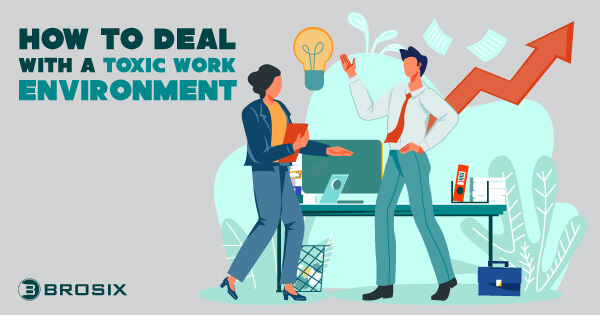Are you dealing with a toxic work environment?
There are days when everyone struggles with work. We all have challenging weeks, painful Mondays, and difficult tasks to overcome from time to time. The occasional bad day doesn’t create a toxic work environment. However, if you’re constantly overwhelmed by stress, are unable to communicate effectively with your coworkers and feel burnout is just around the corner, there may be a problem.
A toxic work environment is a problem for everyone involved. Employees suffer from poor wellbeing, higher stress levels and even deteriorating health. While businesses feel the after effects of low productivity, high turnover and poor morale.
In fact, studies show that 1 in 5 employees have left a role at some point in their career due to a toxic work environment.
So, how do you define a toxic work environment, and what do you do if you discover you’re part of one? Here’s your complete guide to tackling toxicity in the workplace.
What Is a Toxic Work Environment? The Basics
A toxic work environment, or toxic workplace, is an environment where negative behaviors become intrinsic to company culture. Rather than nurturing employee productivity and engagement, toxic work environments constantly beat team members down with bullying, manipulation, poor collaboration and generally bad vibes.
Essentially, a toxic work environment makes employees feel psychologically unsafe. Team members are afraid to speak up and share concerns for fear of backlash. Creativity begins to dwindle and employees start to show signs of depression, anxiety and burnout.
Unfortunately, while employers are beginning to pay more attention to the importance of positive company culture in the workplace, toxic environments can still thrive. Around 30 million US workers say that their workplace feels toxic, according to one MIT study.
Aside from having a negative impact on both mental and physical health for staff, a toxic work environment also influences the performance of the business. Around 38% of staff members say that their work quality decreases when they’re in a toxic environment. This means that tackling toxicity isn’t just something employees need to consider. It’s a task for business leaders to address too.
The Common Signs of a Toxic Work Environment
One of the reasons toxicity is so difficult to cure in the workplace, is that it can appear in a multitude of different forms. Most of the time, toxic environments emerge over time, they grow slowly, as a result of poor leadership, problematic practices and constant issues between teams.
For some companies, the first signs of a toxic workplace may be obvious. It’s easy to see cliques forming in a company, creating exclusionary experiences for other teams. However, toxicity can also start more subtly, with poor communication and collaboration.
The most common signs of a toxic work environment include:
1. Problematic Communication
Your team and company culture can’t thrive if your teams aren’t communicating effectively. Good communication, collaboration and cooperation all go hand-in-hand. Unfortunately, it can be difficult to cultivate healthy communication in a team environment, particularly when every staff member has their own methods and styles of interacting.
Watch for signs of limited interaction between staff members, poor clarity around projects and weak listening skills among workers. Be aware of passive-aggressive communication, or inconsistency in the way team members receive instructions and guidance. Ensure your teams can connect clearly and effectively across a multitude of channels, to pave the way for interactive work.
2. Poor Leadership
As mentioned above, a toxic work environment is frequently a sign of poor leadership. In any workplace, employees turn to leaders for guidance on how to act. If leaders are dismissive, fail to provide necessary clarity or show bias towards team members, the environment falls apart.
There are many different types of bad bosses that can nurture toxicity in the workplace. Some consistently pass the blame for mistakes onto their employees, others fail to show respect to staff and some even ignore crucial duties, like getting to know their teams. Any leader in a business environment should know how to motivate, support and constantly engage their teams. Crucially, excellent leaders are also transparent. They don’t hide information from employees or leave them out of the loop. Make sure your leaders are open, honest and inspiring.
3. Workplace Silos and Cliques
It’s natural for certain groups in the workplace to form stronger bonds over time. Employees who work closely together every day are more likely to develop a rapport than those who rarely interact. However, the workplace shouldn’t feel exclusionary. When cliques emerge in a business environment, they shut other team members out, leading to a poor flow of knowledge.
Not only do cliques harm the mental health and confidence of other staff members, but they can also hamper productivity, by making it harder for staff to share insights. A business with a robust collaboration strategy should focus on bringing staff members from all environments together regularly. Consistent all-hand meetings, team building exercises and even regular messaging between different groups can help to build trust in the workplace.
4. Non-Existent Motivation
High levels of motivation can be tricky to maintain in any environment. Challenging tasks, limited feedback and various other factors can contribute to a lack of engagement among staff. In fact, according to a recent study, around 51% of employees are disengaged at work.
However, few things drain motivation more than a toxic work environment. If employees are miserable at work, they’re more likely to disconnect from their tasks.
Unhappy employees can’t put 100% of their effort and energy into what they’re doing, because they’re too busy battling stress and discomfort. If teams start to miss deadlines, employees fail to volunteer for new projects and staff consistently seem disinterested or disconnected from the workplace, this could be a sign that toxicity is thriving.
5. Stagnant Growth
All companies evolve at different paces. Not every workplace will have constant opportunities for promotions available to their staff. However, the best environments will constantly invest in nurturing and developing their teams. Even if staff members don’t have the opportunity to move into a new position straight away, they should have chances to learn and enhance their skills.
If the workplace doesn’t offer any opportunities for team members to grow and evolve, staff can begin to stagnate in their roles. This has a direct impact on motivation and productivity levels, as well as employee retention. If staff don’t feel they have a future with a business, they’re more likely to start looking for roles elsewhere.
6. Increasing Turnover
Higher turnover is a common issue in today’s world. Since 2019, turnover has been increasing among every business at a rate of around 8.7%. With more opportunities available for remote and hybrid work, staff members are looking for opportunities elsewhere more frequently. However, an excellent company culture will often convince teams to stick around for longer.
On the other hand, if a workplace is toxic, staff members will often look for opportunities to leave as quickly as possible. If business leaders notice that the number of staff in their workforce is consistently dropping and they’re struggling to attract new talent, this is a sure sign that the workplace is toxic. Even if employees are being constantly fired, this could also be a sign that leadership issues and problematic cultures are leading to disputes among teams.
7. Poor Employee Relationships
Though team members don’t have to be best friends to work together, they need to be able to cooperate and communicate effectively. Conflict can arise in any team environment, but staff should be able to put their issues aside and work together. However, this can be difficult in a toxic work environment, where trust and collaboration are non-existent.
Even in a remote work landscape, it’s important for business leaders to consistently nurture and encourage productive relationships between teams. Managers and supervisors should champion inclusivity and diversity in the workplace, help staff members to connect regularly and look for effective ways to minimize conflict. Be careful about encouraging too much competition in the workplace too. A little competition can be motivational, but too much can lead to staff sabotaging each other.
8. No Work-Life Balance
Every business leader wants their team members to be committed to their work, and invested in their role. However, it’s important for company managers and owners to see their staff as people, with lives outside of work. Work-life balance is something virtually every employee demands in today’s world, but in toxic work environments, the balance between work and personal life can falter.
Teams should be able to switch off the notifications they receive from their messaging apps when they’re not in the office. They shouldn’t have to constantly work overtime unless they choose to do so, and they shouldn’t need to take their work home with them. Human beings need adequate time away from the workplace to rest and recuperate so they can stay productive. With this in mind, business leaders should encourage staff to set healthy boundaries, take regular breaks and enjoy the vacation days and time off they earn.
9. Employee Burnout
Perhaps one of the biggest signs of a toxic work environment is consistent burnout. Around 77% of employees today say they have experienced burnout in their current roles. This issue is becoming more prominent at a time when teams are struggling to adapt to hybrid and remote working environments, which blur the lines between their professional and personal lives.
Burnout is an issue that both business leaders and employees need to tackle together. Team members need to set the right boundaries and communicate their needs to their employers. At the same time, business leaders need to ensure that they’re supporting their staff, with access to flexible time off, mental and physical health guidance, and regular assistance.
10. Increased Absenteeism
Finally, a toxic work environment doesn’t just have an impact on the mental health of teams, it can influence their physical health too. When we’re constantly overwhelmed by negative experiences at work, the side effects often follow us home. Stress at work can lead to trouble eating and sleeping correctly, exhaustion and physical sickness.
If staff members start requesting a lot of extra time off work, or take advantage of any excuse to leave the office, this is a clear sign that the workplace is becoming toxic. Pay attention to employees constantly complaining of headaches, fatigue or sickness.
How to Deal with a Toxic Work Environment
There are two parties that can deal with a toxic work environment: the employee and the employer. If you’re an employee trying to figure out how to survive a toxic work environment, try the following tips:
- Speak to leadership: Sometimes, even the most intuitive business leaders can miss the signs of a toxic work environment. If you’re struggling, and you can see other employees in your workforce having a hard time, addressing these issues with leadership can pave the way for positive change.
- Address the issue directly: If the source of toxicity in your workplace is another colleague or coworker, speak to them about their behavior. If you’re concerned that this is going to lead to further conflict, you could consider approaching human resources instead.
- Look after yourself: Commit to regular self-care. Set boundaries to reclaim your agency over your work-life balance, and find time to relax and unwind when you’re not at work. Prioritize your own health and wellbeing over anything else.
- Consider an exit strategy: If it seems as though the toxicity in your workplace can’t be fixed, it might be worth looking for a new job. Start searching for different positions, and make sure you research the company culture for any business you consider working with.
For business leaders, addressing a toxic work environment can be a little more complex. To begin, you’ll need to determine where the toxicity is stemming from. This means speaking to your employees, and finding out what’s contributing to their stress and discomfort. Create an open communication strategy to ensure staff can reach out to you and share their concerns safely.
Once you know what’s feeding the toxicity in your workplace, you can begin to develop strategies to overcome the issue. For instance, if the problem is poor communication, it might be time to invest in new tools to help staff connect. For instance, Brosix offers an all-in-one environment where staff members can communicate freely through chat, video and audio, in a cloud space.
Not only does Brosix support better, more streamlined communication, but it can also break down silos between teams, making it easier for staff to share documents, brainstorm together and even connect over creative ideas with whiteboarding sessions.
Overcoming Toxicity in the Workplace
A toxic workplace is a serious problem for employees and business leaders alike. Left to fester, toxicity can significantly harm the health and wellbeing of employees, while preventing businesses from reaching their true potential.
Although a toxic workplace can be complicated to overcome, business leaders and employees can work together to turn a problematic work environment into something more nurturing and effective for everyone involved. Collaborate with your team on cultivating a workplace where everyone feels supported, respected and comfortable to perform at their best.









